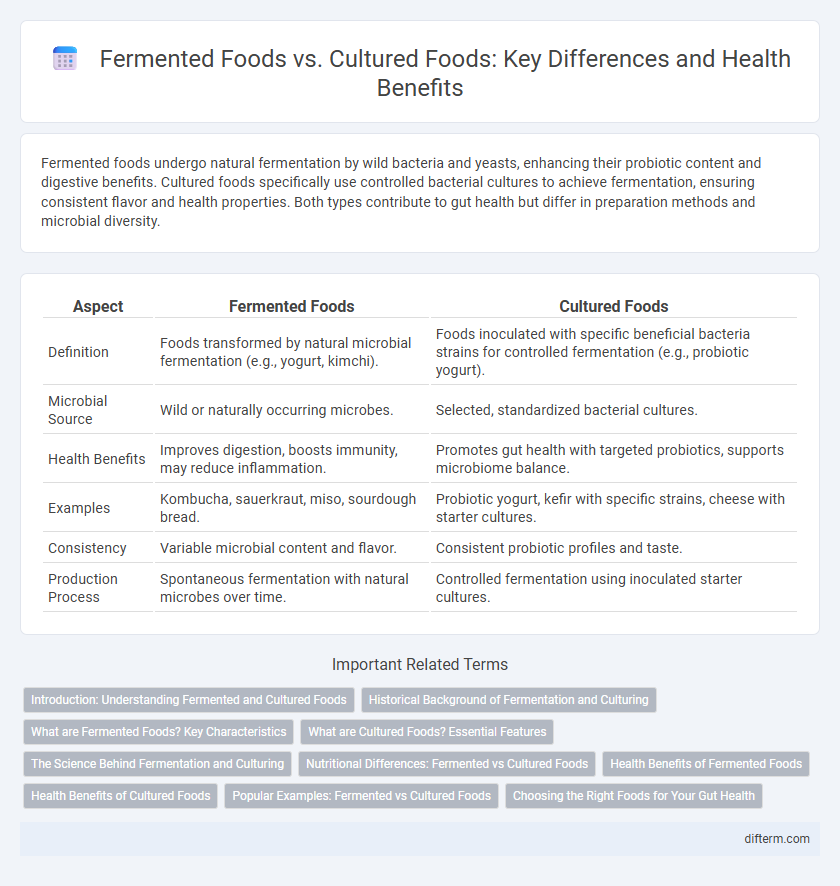Fermented foods undergo natural fermentation by wild bacteria and yeasts, enhancing their probiotic content and digestive benefits. Cultured foods specifically use controlled bacterial cultures to achieve fermentation, ensuring consistent flavor and health properties. Both types contribute to gut health but differ in preparation methods and microbial diversity.
Table of Comparison
| Aspect | Fermented Foods | Cultured Foods |
|---|---|---|
| Definition | Foods transformed by natural microbial fermentation (e.g., yogurt, kimchi). | Foods inoculated with specific beneficial bacteria strains for controlled fermentation (e.g., probiotic yogurt). |
| Microbial Source | Wild or naturally occurring microbes. | Selected, standardized bacterial cultures. |
| Health Benefits | Improves digestion, boosts immunity, may reduce inflammation. | Promotes gut health with targeted probiotics, supports microbiome balance. |
| Examples | Kombucha, sauerkraut, miso, sourdough bread. | Probiotic yogurt, kefir with specific strains, cheese with starter cultures. |
| Consistency | Variable microbial content and flavor. | Consistent probiotic profiles and taste. |
| Production Process | Spontaneous fermentation with natural microbes over time. | Controlled fermentation using inoculated starter cultures. |
Introduction: Understanding Fermented and Cultured Foods
Fermented foods, such as kimchi, sauerkraut, and yogurt, undergo a natural process where microorganisms like bacteria and yeast convert sugars into acids or alcohol, enhancing flavor and preservation. Cultured foods specifically involve the intentional introduction of beneficial bacteria, often probiotics, to promote gut health and digestion. Both food types offer unique health benefits by supporting a balanced microbiome and improving nutrient absorption.
Historical Background of Fermentation and Culturing
Fermented foods, dating back over 7,000 years, harness the natural process of microbial fermentation to preserve and enhance the nutritional profile of foods like sauerkraut, kimchi, and yogurt. Cultured foods specifically involve the deliberate introduction of beneficial bacteria or yeasts, such as Lactobacillus in yogurt or kefir, to develop unique flavors and probiotic benefits. The historical use of fermentation and culturing techniques across ancient civilizations highlights their essential role in food preservation, digestion, and gut health maintenance.
What are Fermented Foods? Key Characteristics
Fermented foods are products transformed by the metabolic activity of microorganisms such as bacteria, yeast, or molds, which break down sugars and starches into beneficial compounds. Key characteristics include enhanced flavor, improved digestibility, extended shelf life, and the presence of probiotics that support gut health. Common examples are yogurt, kimchi, sauerkraut, and kombucha, which contribute to a balanced microbiome and overall wellness.
What are Cultured Foods? Essential Features
Cultured foods are products made through the controlled fermentation of beneficial bacteria, yeasts, or molds, which enhance flavor and nutritional value. Essential features include the presence of live microorganisms that promote gut health, improved digestibility, and preservation without artificial additives. Common examples of cultured foods include yogurt, kefir, sauerkraut, kimchi, and miso, all known for their probiotic benefits.
The Science Behind Fermentation and Culturing
Fermented foods result from the natural process where microorganisms like bacteria and yeast break down sugars, producing beneficial compounds such as probiotics, enzymes, and organic acids. Cultured foods involve the deliberate introduction of specific strains of bacteria to milk or other substrates, promoting controlled fermentation that enhances nutritional profiles and gut health. Both processes leverage microbial activity to improve digestibility, increase nutrient bioavailability, and support a balanced microbiome.
Nutritional Differences: Fermented vs Cultured Foods
Fermented foods undergo natural microbial transformation, enriching them with probiotics, vitamins, and enzymes that enhance gut health and nutrient absorption. Cultured foods specifically involve the addition of selected strains of beneficial bacteria, often resulting in more controlled probiotic content and consistent nutritional profiles. Both contribute to improved digestive health, but fermented foods tend to have a broader range of microbial diversity compared to the targeted strains found in cultured products.
Health Benefits of Fermented Foods
Fermented foods, rich in probiotics such as Lactobacillus and Bifidobacterium strains, promote gut health by enhancing the balance of beneficial microbiota and improving digestion. These foods, including yogurt, kimchi, and sauerkraut, boost the immune system, reduce inflammation, and may contribute to better mental health through the gut-brain axis. Regular consumption of fermented foods supports nutrient absorption and helps prevent gastrointestinal disorders like irritable bowel syndrome (IBS) and antibiotic-associated diarrhea.
Health Benefits of Cultured Foods
Cultured foods, rich in probiotics like Lactobacillus and Bifidobacterium, enhance gut health by promoting balanced gut microbiota and improving digestion. They are linked to strengthened immune function and reduced inflammation due to bioactive compounds generated during fermentation. Regular consumption of cultured foods such as yogurt, kefir, and kimchi supports nutrient absorption and may help prevent gastrointestinal disorders.
Popular Examples: Fermented vs Cultured Foods
Kimchi, sauerkraut, and kombucha rank among popular fermented foods known for their probiotic benefits and rich microbial diversity. Cultured foods such as yogurt, kefir, and cultured butter undergo controlled fermentation processes, featuring specific bacterial strains to enhance digestive health. Both categories contribute to gut microbiome balance but differ in preparation methods and microbial composition.
Choosing the Right Foods for Your Gut Health
Fermented foods like kimchi, sauerkraut, and miso are rich in naturally occurring probiotics that can enhance gut microbiota diversity and improve digestion. Cultured foods such as yogurt and kefir contain specific strains of beneficial bacteria introduced during fermentation, offering targeted probiotic benefits. Selecting the right foods based on your digestive needs and probiotic content supports optimal gut health and overall well-being.
Fermented Foods vs Cultured Foods Infographic

 difterm.com
difterm.com